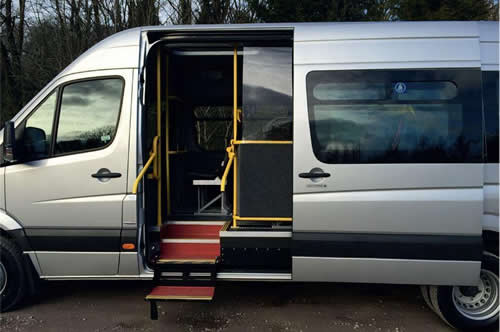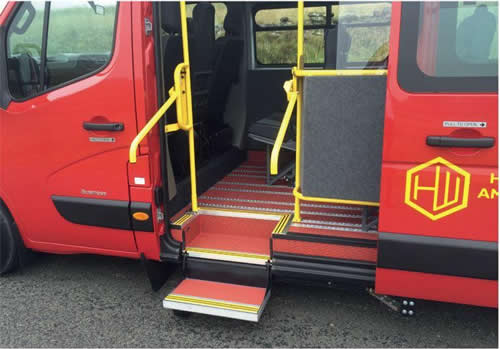The first point to note is that the choice of base vehicle will have a strong bearing on the type of walk-in passenger entrance.
As explained in the previous section, the entrance for a minibus can be to the nearside front, directly opposite the driver, or through the side loading door, which usually offers increased headroom.
M2 Type Approval regulations dictate maximum step heights and minimum step tread dimensions. Therefore, all minibuses that are based on a panel van (bar a few unusual examples) will feature an auxiliary step to the side passenger entrance.
Depending on the design of the base vehicle, this may be mounted below the entrance or fitted into the standard stepwell.

Cassette step with vertical and half height rail and modesty screen
Certain models can feature a special cut-in stepwell and flush folding step. The step lies flush with the saloon floor when not in use, and, when lowered, provides either three or four low entry steps depending on the type of base vehicle.

Flush-folding four-step entrance with twin fold-out rails, modesty screen and weather screen above it

Flush folding three-step entry with twin fold-out rails, modesty screen and weather screen
Sometimes, a cassette step below the entrance is the only practical solution, despite this requiring regular cleaning and being at greater risk of accident damage. A cassette step may be manually deployed (foot operated) or electrically operated either when the door opens or when operated by the driver. A step mounted in this position is exposed to harsh conditions, and when this option is selected, only the better, more expensive models should be considered.
A manual cassette step would have a buzzer to warn the driver if it has been left out when the vehicle is moving, whilst an electric version should have an automatic retract feature. On some minibuses, we can offer a power-operated door. This would be electrically operated, possibly in conjunction with an electrically-operated auxiliary step. Costs can vary significantly subject to the choice of base vehicle and type of door.

Basic, ‘OE’ step with single vertical rail
As a legal requirement, all minibuses must feature a grab handle to assist entry at the passenger door, though in practice most of our vehicles would feature additional handrails, to each side of the entrance, whether these be fixed or folding.
Generally, handrails are 32mm in diameter, slip resistant and colour coated to contrast with the background.
Highlighted step edges can be specified for the passenger entrance. They clearly identify the parameter of the step and are of particular benefit to the partially sighted.

Flush folding three-step entry with vertical and half-height rail and modesty screen

Cassette step to underside of standard stepwell

Cassette step to underside of deepened stepwell, plus handrails










